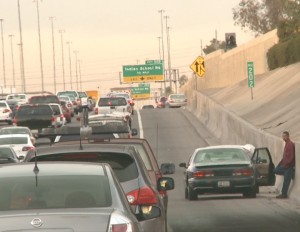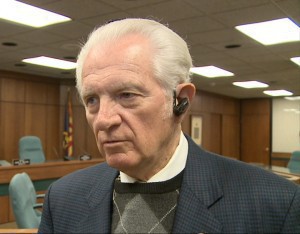- Slug: BC-CNS-Move Over,450
- Sidebar: Key provisions of bill.
- Photos available (thumbnails, captions below)
By SPRING ESELGROTH
Cronkite News Service
PHOENIX _ Requiring drivers to move over or at least slow down when approaching any vehicle parked in the emergency lane would reduce the possibility of accidents and save lives, a state lawmaker said.
Sen. John Nelson, R-Glendale, has proposed expanding a law that currently requires motorists to move over or slow down only when emergency vehicles are in the shoulder.
Arizona’s freeways are dangerous for stranded motorists and for everyone who works to help them, he said.
“When you have somebody that’s broken down on the side of the road … and nobody stops to think about slowing down or moving over and you’ve got somebody getting out of their car and they can’t get out of the way, you’re going to hit somebody,” Nelson said.
Twenty-nine states have comprehensive “move over” laws that include tow trucks and roadside-assistance vehicles, according to AAA.
The Senate Natural Resources and Transportation Committee, which Nelson chairs, endorsed SB 1133 this week, sending it to the floor by way of the Rules Committee.
Since 2005, Arizona has had a “move over” law requiring motorists to yield one lane when approaching an emergency vehicle with its lights flashing on the side of the road. If they are unable to move over, motorists must reduce speed and approach with caution.
The bill would include roadside-assistance vehicles such as tow trucks and any other vehicle displaying alternating flashing lights or warning lights.
It also would encourage defensive driving schools teach proper right-of-way and yielding techniques and educate about the law.
Representatives of AAA Arizona, which pressed for the change, said a 2008 collision along an East Valley freeway illustrates the need for expanding the law. In that accident, a truck driver who didn’t move over struck and killed a tow truck driver and the motorist he was assisting.
“This is necessary for those people who put their lives on the line every day,” said Michelle Donati, AAA spokeswoman.
Daniel Stubbs, owner of Phoenix Towing Service, said increasing public awareness is key.
“The average person has no idea what the new laws are, and a small percentage of people are aware of the ‘move over’ law,” he said. “If you’ve ever driven on the 101, you know that lots of people are in jeopardy.”
Expanding the law would give peace of mind to roadside-assistance workers such as Matt Mendonsa, fleet manager for AAA who responds daily to stranded motorists along freeways.
“Some days, especially in rush hour traffic, you’ve got motorists out there texting and not paying attention to the road, so it’s nerve-racking,” Mendonsa told Cronkite NewsWatch. “It would make it a little easier if this law were to get passed.”
This is Nelson’s second attempt to pass the bill. His 2010 version passed the Senate but failed to receive a hearing in the House. A 2009 House bill applying to tow trucks failed to receive a hearing.
In the end, Nelson said, it’s about common sense and proceeding with caution when you see any vehicle in the emergency lane.
“If you see trucks and vehicles with flashing lights or diamond signs that catch your eye and you see somebody broken down, all this is saying is slow down, be careful, and if you have the ability, move over,” he said.
^___=
Key provisions of current ‘move over’ law:
– Applies to police and emergency personnel displaying flashing lights.
– Requires motorist to move over one lane when possible or reduce speed and proceed with caution.
– Violators are subject to a maximum penalty fine of $250.
^___=

SB 1133, sponsored by Sen. John Nelson, R-Glendale, would require motorists to move over or slow down for any vehicle parked in the emergency lane. (Cronkite News Service Photo by Laura Yanez)

Nelson attempted to pass similar legislation in 2010, but the bill failed to receive a hearing in the House after passing in the Senate. (Cronkite News Service Photo by Laura Yanez)